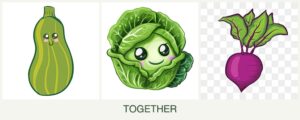
Can you plant onions, mint and chives together?
Can You Plant Onions, Mint, and Chives Together?
Companion planting is a popular gardening practice where certain plants are grown together to enhance growth, deter pests, and improve yields. Onions, mint, and chives are common in herb and vegetable gardens, but can they thrive when planted together? This article explores their compatibility, growth needs, and the benefits and challenges of growing them side by side.
Compatibility Analysis
Yes, you can plant onions, mint, and chives together, but with some considerations. These plants can complement each other in terms of pest control and space utilization. Onions and chives, both members of the allium family, share similar growth requirements, making them suitable companions. Mint, with its robust growth and pest-repelling properties, can also fit into this trio, provided its invasive nature is managed.
Key Factors
- Growth Requirements: Onions and chives thrive in similar conditions, needing full sun and well-drained soil. Mint prefers moist soil but can adapt to various light conditions.
- Pest Control: Alliums like onions and chives repel pests such as aphids and carrot flies. Mint deters ants and mosquitoes, adding an extra layer of protection.
- Nutrient Needs: These plants have moderate nutrient requirements, but mint’s aggressive growth can compete for resources.
- Spacing: Adequate spacing is crucial to prevent mint from overwhelming the others and to ensure all plants receive enough sunlight and nutrients.
Growing Requirements Comparison Table
| Plant | Sunlight Needs | Water Requirements | Soil pH & Type | Hardiness Zones | Spacing Requirements | Growth Habit |
|---|---|---|---|---|---|---|
| Onions | Full sun | Moderate | 6.0-7.0, well-drained | 3-9 | 4-6 inches | Upright, bulbous |
| Mint | Full sun to partial shade | High | 6.0-7.5, moist, rich | 3-8 | 12-18 inches | Spreading, invasive |
| Chives | Full sun | Moderate | 6.0-7.0, well-drained | 3-9 | 8-12 inches | Clump-forming |
Benefits of Planting Together
- Pest Repellent Properties: Onions and chives deter common garden pests, while mint adds protection against ants and mosquitoes.
- Improved Growth and Flavor: The aromatic nature of mint can enhance the flavor profile of nearby plants, including chives.
- Space Efficiency: By understanding their growth habits, you can maximize space in your garden. Chives and onions can be planted closer together, while mint can occupy a separate, contained area.
- Soil Health Benefits: The varied root systems can help improve soil structure and nutrient distribution.
- Pollinator Attraction: Chive flowers attract bees, beneficial for pollination.
Potential Challenges
- Competition for Resources: Mint’s aggressive growth can overshadow onions and chives, competing for water and nutrients.
- Different Watering Needs: Mint requires more water than onions and chives, necessitating careful watering strategies.
- Disease Susceptibility: Overcrowding can lead to fungal diseases, especially in humid conditions.
- Harvesting Considerations: Ensure easy access to each plant for harvesting without disturbing the others.
Practical Solutions
- Containment: Plant mint in containers or use root barriers to control its spread.
- Strategic Watering: Implement drip irrigation or mulch to balance moisture levels.
- Regular Maintenance: Prune mint regularly to prevent it from overtaking other plants.
Planting Tips & Best Practices
- Optimal Spacing: Maintain at least 12 inches between mint and other plants. Onions and chives can be spaced closer, around 4-6 inches apart.
- Timing: Plant onions and chives in early spring. Mint can be planted after the last frost.
- Container vs. Garden Bed: Consider planting mint in containers to prevent its spread, while onions and chives can thrive in garden beds.
- Soil Preparation: Enrich soil with organic matter and ensure proper drainage.
- Companion Plants: Consider adding basil or carrots, which pair well with all three.
FAQ Section
-
Can you plant onions and mint in the same pot?
- It’s best to plant mint in a separate container due to its invasive nature.
-
How far apart should onions and chives be planted?
- Space them 4-6 inches apart for optimal growth.
-
Do onions and mint need the same amount of water?
- No, mint requires more water than onions.
-
What should not be planted with mint?
- Avoid planting mint with other herbs that it can easily overshadow, such as parsley.
-
Will mint affect the taste of onions?
- Mint can enhance the aromatic profile but won’t directly alter the taste of onions.
-
When is the best time to plant these together?
- Early spring is ideal for onions and chives, while mint should wait until after the last frost.
By understanding these dynamics, you can successfully grow onions, mint, and chives together, maximizing their benefits while minimizing challenges.



Leave a Reply